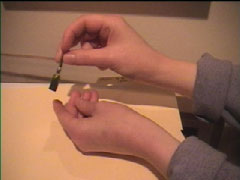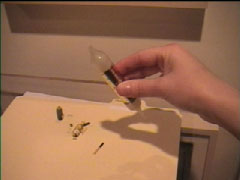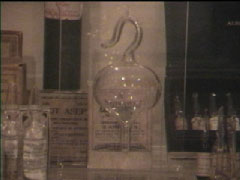click to enlarge
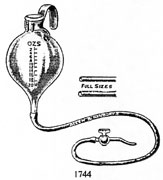
Figure 1
Sir Roger’s Infusion Apparatus,
A Catalogue of Surgical
Instruments and Medical
Appliances,Allen &
Hanburys Ltd., London, 1938, p. 186
To the Editor:
Stimulated by the article “Paris Air” or “Holy Ampule” by Girst and Shearer in the December 1999 issue ofTout-fait, I conducted some research about the history of infusion medicine. The “Paris Air” ampule used by Duchamp for his artwork combines three main functions of an infusion apparatus. First it can be used as a closed vessel to keep sterilized fluids. Second it can be used as an infusion apparatus. (One simply has to break the far glass ends, connect a tube infusion system to the lower one and gravity draws the fluid into the patient’s vein.) Third it is the most convenient apparatus to hang over the patient’s bed because of its glass hook. Most strikingly, the “Paris Air” ampule combines all three functions in one piece made of the same uniform material.
By using a medical infusion ampule for his artwork Duchamp cites, likely without knowing, from a very interesting part of the history of medicine. Blood letting as a medical treatment has been known since ancient times, but its contrary “infusion” was not tried until Harvey discovered the system of blood circulation in the mid 17th century. In 1656 Sir Christopher Wren wrote the first report about experiments of injections into dogs‘ veins. Although he was a successful medical scientist of his time he changed his profession in 1665 to architecture and built fifty churches in London including the famous St. Paul’s Cathedral. (Remember that the ancient Egyptian god of medicine, Imhotep, used to be a physician and architect as well.) The first report of venous injections into humans was published by Johann Sigismund Elsholtz in Berlin in 1665. (1) Lacking proper materials like small needles and microbiological knowledge like methods of sterilization, the next reports suggesting infusions as a standard medical treatment were not published before the late 19th century. Most of these reports describe different infusion equipment as well as methods of sterilization. Again, it took nearly two to three decades until infusions became a well-established treatment in World War I and World War II.
click to enlarge
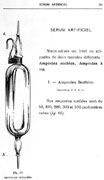
Figure 2
Closed Sterile Ampoule,
de l’Asepsie dans la Pratique
Chirurgicale Procedes de Sterilisation,
de Robert & Leseurre, 1930, 141
Closed ampules as a container of pharmaceutical products were first described by Harnack in 1883 (2). Three years later they were brought into mass production by Limousin in Paris(3).
Most of the first infusion vessels were open systems like the example of Sir Roger’s infusion apparatus (figure 1)(4). It resembles the shape of the “Paris Air” ampule, but the top end is open and bears a metal hook. Also some closed sterile ampules existed like the one described by de Robert & Leseurre in 1903 (figure 2), which combined a sterile container and infusion apparatus(5).
The one report about an infusion apparatus which resembles the “Paris Air” ampule best was published by Maurice Boureau in Paris in 1898 (figure 3) (6). Boureau describes a method of sterilization and the use of what he calls an “Infusion Ball” for infusing “Serum Artificial.” In medical terms “Serum Artificial” is synonymous to “Serum Physiologique” which is also printed on the “Paris Air” ampule and describes a 0.7% – 0.9% Sodium Chloride solution.
click to enlarge
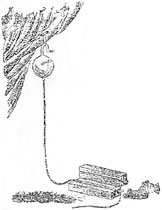
Figure 3
Infusion Apparatus, published
by Maurice Boureau in Paris,
1930, seen from
Zur Entwicklung der Infusion
slösungen in der ersten Hälfte
des 20. Jahrhunderts,
Karin Bischof, Diss. Basel,
1995, p. 307
Some questions still remain unanswered. 1. If Boureau’s report is from 1898 but Duchamp didn’t buy his ampule till 1919, could he have bought an actual “Infusion Ball?” 2. What size is an “Infusion Ball”? Trying to answer the first question one has to bear two conditions in mind: Pharmacists have always been very traditional, therefore using old pharmaceutical/medical instruments for decoration of their pharmacies. Moreover, early in the 20th century the production of pharmaceutical products was individual rather than mass production. The first condition leaves the possibility that Duchamp bought an old instrument. However, because of the second condition, it is still possible that Duchamp bought a new ampule because infusion systems and ampules varied a lot in shape and design. The latter may also be the answer to the second question. If the ampule used by Duchamp was an “Infusion Ball” there is no need to argue about the size. Like most medical/pharmaceutical instruments infusion systems were and are available in a great variety of sizes for different medical indications.
In summary, especially with the knowledge of the Boureau report, it becomes more likely that Duchamp bought an infusion ampule made after Boureau’s description for his “Paris Air” artwork rather than having had one produced by a skilled pharmacist. Why would a pharmacist produce a unique “Paris Air” ampule resembling the “Holy Ampule” when there already existed a pharmaceutical/medical apparatus like Boureau’s “Infusion Ball” which resembled the shape of the “Paris Air” ampule even better?
Yours,
Cand. Med. Tobias Else, Innsbruck, Austria
Notes
 1. Elsholtz, Johann Sigismund. Neue Clystier Kunst wodurch eine Arzney durch eine eroffnete Ader beyzubringen. Berlin 1665
1. Elsholtz, Johann Sigismund. Neue Clystier Kunst wodurch eine Arzney durch eine eroffnete Ader beyzubringen. Berlin 1665
 2. Harnack, Erich. Lehrbuch der Azneimittellehre und Arzneiverordnungslehre. Auf Grund der dritten Auflage des Lehrbuchs der Arzneimittellehre von R. Buchheim und der Pharmacopoea Germanica. ed. II. Hamburg/Leipzig 1883.
2. Harnack, Erich. Lehrbuch der Azneimittellehre und Arzneiverordnungslehre. Auf Grund der dritten Auflage des Lehrbuchs der Arzneimittellehre von R. Buchheim und der Pharmacopoea Germanica. ed. II. Hamburg/Leipzig 1883.
 3. Limousin, S. “Ampules hypodermiques, nouveau mode de preparation des solutions pour les injections hypodermiques” in Archives de Pharmacie I, 1886.
3. Limousin, S. “Ampules hypodermiques, nouveau mode de preparation des solutions pour les injections hypodermiques” in Archives de Pharmacie I, 1886.
 4. Figure taken from Allen & Hanburys Ltd. A Catalogue of Surgical Instruments and Medical Appliances. London 1938.
4. Figure taken from Allen & Hanburys Ltd. A Catalogue of Surgical Instruments and Medical Appliances. London 1938.
 5. de Robert & Leseurre. “de l’Asepsie dans la Pratique Chirurgicale Procedes de Sterilisation.”
5. de Robert & Leseurre. “de l’Asepsie dans la Pratique Chirurgicale Procedes de Sterilisation.”
 6. Boureau, Maurice. “La technique des injections de serum artificial,” Diss. Med. Paris 1898. Figure taken from Bischof , Karin. “Zur Entwicklung der Infusionslösungen in der ersten Hälfte des 20. Jahrhunderts,” Diss. Basel 1995
6. Boureau, Maurice. “La technique des injections de serum artificial,” Diss. Med. Paris 1898. Figure taken from Bischof , Karin. “Zur Entwicklung der Infusionslösungen in der ersten Hälfte des 20. Jahrhunderts,” Diss. Basel 1995
Rhonda Roland Shearer responds:
click to enlarge
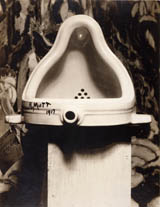
Figure A
Marcel Duchamp,
Fountain, 1917

Figure B
Marcel Duchamp, Trébuche
t (Trap), 1917

Figure C
Marcel Duchamp,
Hat Rack, 1917
We truly appreciate the effort that you made to research the historical context for Duchamp’s alleged “Paris Air Medical Ampule.”
Despite Duchamp’s contention that his objects were mass-produced readymades, the fact remains that no exact duplicate exists for any of his productions in the historical record. No scholar has ever found — in any museum catalogue or collection, or dealers’ storerooms — any exact object (urinal, coatrack, hatrack, etc.) that, according to Duchamp’s claims, was mass produced, store bought and readymade. Is this not strange? If an object is mass produced, by definition and logic, the attempt to find a duplicate design should not be analogous to searching for a needle in a haystack or scraping the bottom of a barrel, as has been the case.
So little evidence exists for the art historical othodoxy’s assumption — namely, that readymades are mass produced, and were therefore readily found in stores. Therefore, a reversal of the typical question of evidence about the status of Duchamp’s objects must be proposed. We should be persuaded by, and judge only by, direct evidence any claim that Duchamp objects are, in fact, readymade.
Using three illustrations of infusion devises, your letter lists three criteria met by Duchamp’s ampule in your judgement.
1. A closed vessel for sterilization
2.It can be used as an infusion system (with a bottom to break for connection to a tube)
3.”Convenient apparatus to hang over the patient’s bed because of the glass hook”
Yet when I look at your three illustrations, I fail to follow your conclusion that the Paris Air ampule “combines all three functions in one piece made of the same uniform material.”
Figure 1 does not have a glass hook and, like Figure 2, is safely and securely held by a metal clasp. Therefore the hook and the ampule are separate, not uniform materials as in Duchamp’s ampules. Indeed, Figure 3 is very suggestive — but unlike Figure 1 and 2, which appear to be accurate technical drawings from medical catalogues, Figure 3 with its inclusion of a hanging curtain and rough, hand-drawn quality is unclear. Considering Figure 3’s earlier 19th century date, this device was replaced by more practical and safe designs shown in Figure 1 and 2. The cylinder form of Figure 2 shares, with the mass-produced ampules developed in France during the first years of the 20th century, a shape that can be safely packed into boxed rows (see my illustration A of an early 20th century ampule mass-production factory).
click to enlarge
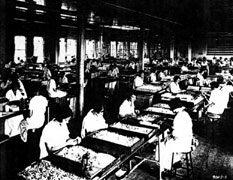
Illustration A
Photograph showing a factory
mass-producing ampules,
France, early 20th century
I have handled many European and American ampules and have “opened” them (see video). It would have been very tricky to attach a hose to the jagged end of an ampule. If indeed a glass hook was ever incorporated (as Figuer 3 is unclear), the motion of a patient’s arm would have led to stress on a glass hook that would likely cause it to break or become dislodged. Logic and practicality would lead to the further development of a metal, not a glass hook — as shown by the historical chronology held within your illustrations, beginning with Figure 3, then Figure 1, and 2 as the most historically recent in the series.
But let’s say that you are correct and that Figure 3 was among the early experiments in hand-made infusion devises that Duchamp saw hanging in a pharmacy as an “old pharmaceutical/medical instrument for decoration” (as you write). Is this one-of-a kind and obsolete hand-made infusion ampule to be accepted by us as evidence of Duchamp’s use of a mass produced, easily found, store-bought readymade object?
As to size, I believe that the facts about sizes of infusion balls actually used and made would be extremely important to know. For example, what if infusion ampules — even early custom-made ones — were only more than 125 cc in volume? This fact would further indicate that Duchamp had his own ampule made. Or on the contrary, if you discovered that infusion ball ampules were only made in 35 cc and 125 cc in volume, this would suggest that Duchamp exploited the two standard sizes for his original 1919 and 1941 Boite en Valiseversions, etc. Furthermore, we have testimony by experts that a pharmacist would not have needed unusual skills to convert a mass-produced ampule into a custom-made version similar to Duchamp’s larger 1919 and smaller 1941 Paris Air objects. In fact, Duchamp tells us that he had his 1941 ampules version custom made.
- Click image for video (QT 2.6MB)
- Click image for video (QT 2.6MB)
- Click image for video (QT 2.0MB)
- Demonstration of the
breaking of two antique
ampules at the Art Science
Research Laboratory, NY - More contemporary
ampule(with thicker glass) - Display of various
antique ampules at ASRL, NY
I believe that the question of Duchamp’s readymade ampule is very much aided by your research, but must still continue! I would love to find out more about infusion devices. If, in fact, infusion balls were “available in a great variety of sizes for different medical indications,” evidence and images of mass-produced infusion balls matching Duchamp’s Paris Air (1919) should readily be found, and should now be in the historical record in a duplicate form, not just as resemblances. A duplicate of Paris Air (1919) (alas, for people who want to believe in readymades) has not yet been found. We may be facing another Loch Ness monster or Big Foot. People will believe that Duchamp’s Paris Air (1919) ampule was a mass-produced readymade even in the face of little or no evidence.
Figs. A, B and C
© 2005 Succession Marcel Duchamp, ARS, N.Y./ADAGP, Paris. All rights reserved.



